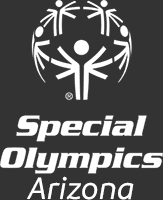What Is Apert Syndrome?
What Is Apert Syndrome?
Apert syndrome is a rare genetic condition that occurs when joints in the skull close too soon during fetal development, resulting in recognizable physical conditions such as a broad, tall forehead and webbed fingers and toes. Apert syndrome is a rare condition, so many people are unaware of the condition. The Special Olympics Arizona team is breaking down Apert syndrome: what it is, what it affects, signs, symptoms, causes, and what to expect if your child has Apert syndrome.
What Is Apert Syndrome?
Apert syndrome is a condition in which joints, or sutures, in the skull of a baby close too early. Areas of the body that are affected by the sutures or joints closing too early include the skull, the point at the top of the head, the face, which includes bones forming in irregular places, and the feet and hands, which may have connected tissue between fingers and toes, also known as webbing. Apert syndrome is genetic and autosomal dominant, meaning that either parent can pass this condition onto their child through their genes.
Who Does Apert Syndrome Affect?
Apert syndrome occurs early in pregnancy as the result of a genetic mutation. The mutation could be inherited or newly formed, “de novo.” If one parent has Apert syndrome, there is a 50% chance that the gene will be passed on to the child. Genetic mutations are not the result of any action or inaction a parent took while pregnant with a child.
What Are the Signs & Symptoms of Apert Syndrome?
Apert syndrome occurs when joints in the skull close too early in development during pregnancy, or craniosynostosis. The early closure of the joints in the skull prevents the bones from completing normal development, causing noticeable changes in the facial bones. There are several defining characteristics of Apert syndrome that a baby could have, depending on what stage of development the joints in the skull began to close. The signs and symptoms include:
- Skull: A baby’s head could be taller than normal and may appear pointed at the top, also known as acrocephaly. The backside of the baby’s skull will be flatter than normal. A high, broad forehead is a sign on the skull of Apert syndrome, as well as the soft spot on a baby’s head being delayed in closing.
- Eyes: A baby with Apert syndrome may have eyes that are widely spaced on the face, as well as eyes that have signs of bulging or slanting downwards.
- Face: A baby could have a flat or beak nose, as well as a cleft palate, which is an opening in the roof of the mouth. A baby with Apert syndrome may have a face that is not symmetrical.
- Hands and feet: A baby with Apert syndrome may have short fingers with a wide thumb, and their fingers or toes may be connected, syndactyly, or webbed.
Aside from physical characteristics, there are other signs and symptoms that you may notice in a baby or child with Apert syndrome:
- Brain: The syndrome causes pressure on the brain which can disrupt cognitive development, how a child learns and thinks. Children with Apert syndrome may face mild to moderate intellectual disability.
- Ears: It’s common for the sides of a child’s head to be the first to close in the early closing of skull joints with Apert syndrome, which will alter how a child’s ears are formed. This may result in frequent ear infections or hearing loss, depending on the severity with which ear development is affected.
- Eyes: Physical effects on the eyes including slanting, bulging or wide eyes, may affect a child’s vision.
- Lungs: Depending on the severity of the diagnosis, the way that a child’s nose is formed may affect their breathing, including blocked airways or sleep apnea.
- Skin: A child with Apert syndrome may produce excess oil on the skin, which can result in severe acne. They may also sweat more than normal and have patches of skin with no hair.
- Teeth: A child with Apert syndrome may have baby teeth which overcrowd their mouth, causing dental problems when teeth start to form. They could also be missing teeth or have irregular enamel forming on their teeth.
Apert Syndrome Causes
A gene mutation in fibroblast growth factor receptor-2 or FGFR2, the gene responsible for skeletal development, is the cause of Apert syndrome. This gene mutation causes receptors to have a lack of communication with fibroblast growth factors, causing joints between bones to close too quickly during development. When these joints close too early, the baby’s brain is still growing, and the bones in the skull and on the side of the head begin to change shape. The irregular formation of bones on the face leads to malformations in other parts of the body.
Apert Syndrome Diagnosis
Diagnosis of Apert syndrome usually occurs after a child is born. The telltale physical signs, such as pointed skull, cleft palate, wide eyes and webbed feet are usually used to determine that a child has Apert syndrome. An early diagnosis of Apert syndrome is possible during pregnancy using 2D or 3D ultrasounds or MRIs to track the development of a baby’s skull. Secondary testing using CT images or MRIs will detect any physical abnormalities once a baby is born. If a baby has physical symptoms, a healthcare provider will likely recommend genetic testing, looking for a mutation of the FGFR2 gene, to confirm the diagnosis. A baby diagnosed with Apert syndrome will still receive regular newborn screenings, with emphasis on a hearing test to check for hearing impairment caused by the condition.
Apert Syndrome Treatment
Treatment for Apert syndrome usually depends on the severity of the diagnosis and symptoms. Treatment often involves some type of surgery to alleviate the child’s symptoms. If a baby has symptoms that affect their skull or brain, such as craniosynostosis or hydrocephalus, a doctor will likely schedule surgery for 2 to 4 months after their birth to insert a corrective shunt that will drain fluid and release pressure from the brain. Reconstructive or corrective surgery may also be performed to adjust any part of the body that developed abnormally, including:
- Surgery to correct the eyes
- Jaw reconstructive surgery
- Plastic surgery of the chin
- Plastic surgery of the nose
- Skull reshaping surgery
- Separation of the toes and fingers
Non-surgical treatment options to alleviate some other symptoms of Apert syndrome may include the use of hearing aids to assist hearing-impaired individuals, breathing machines for individuals with obstructed airways, different therapies such as occupational therapy, speech therapy, or physical therapy, care for a child’s mouth and teeth, and vision assessments due to eye concerns.
How Common Is Apert Syndrome?
Apert syndrome is rare, occurring in only around 1 in every 65,000 births.
What to Expect if Your Child Has Apert Syndrome
Apert syndrome is a lifelong condition with no cure. Surgeries will often occur not long after your baby is born and diagnosed, and close follow-up with multiple specialists will be required to ensure your baby will thrive despite their diagnosis. With ongoing treatments, and after corrective surgeries, babies born with Apert syndrome have very normal life expectancies. Regular health care visits are recommended, as they are with all babies and children, to ensure their teeth, vision, and hearing are developing normally. Your child may require further treatments and surgeries as they grow and develop to target any persisting symptoms. Although Apert syndrome is rare, there is a community of parents who have a child with it, and connecting with other individuals while providing your child with peers who understand their situation can be helpful for you and your child.



